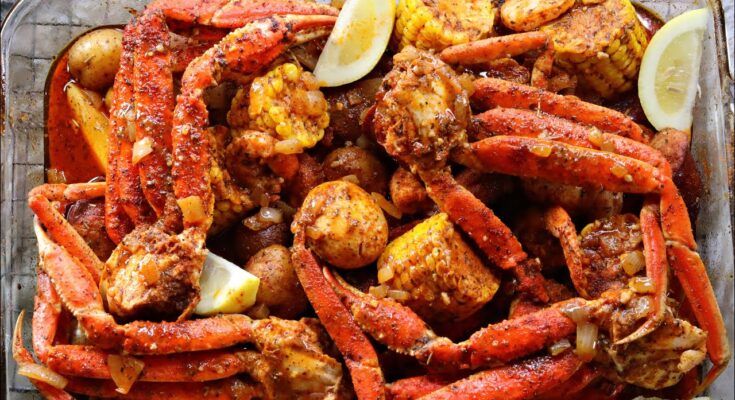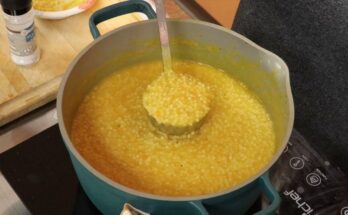Seafood Boil Recipe: There’s something magical about a seafood boil. It’s not just a meal; it’s an experience. Perfect for family gatherings, backyard parties, or even a cozy night in, this dish combines delicious seafood, hearty vegetables, and bold spices into one giant pot of flavor. Originating from coastal regions in the U.S., seafood boils have become a beloved tradition, bringing people together to enjoy fresh, flavorful food with their hands.
In this guide, we’ll walk you through every step of creating a mouthwatering seafood boil at home, ensuring it’s as fun to prepare as it is to eat.
Ingredients for the Perfect Seafood Boil
1. Seafood Selection
The star of the show is, of course, the seafood. Common choices include:
- Shrimp: Large or jumbo shrimp work best for texture and flavor.
- Crab: Snow crab legs or Dungeness crab are popular options.
- Lobster: Adds a touch of luxury.
- Clams and Mussels: Great for soaking up the boil’s flavors.
Pro Tip: Look for fresh, wild-caught seafood whenever possible. If frozen, ensure it’s thawed properly before cooking.
2. Vegetables and Sides
- Corn on the Cob: Sweet corn pairs perfectly with the spicy seasonings.
- Red Potatoes: Adds heartiness and soaks up the seasoning.
- Andouille Sausage (optional): A smoky, spicy sausage that complements the seafood.
For variations, you can substitute sweet potatoes or add other veggies like green beans.
3. Seasonings and Spices
A great seafood boil is all about the spices. You’ll need:
- Old Bay Seasoning: The classic choice.
- Garlic Powder, Paprika, and Cayenne Pepper: For an extra kick.
- Bay Leaves and Lemon Slices: Add freshness to the broth.
4. Tools and Equipment
You’ll need:
- A large stockpot with a lid.
- A strainer or colander.
- Optional: Seafood crackers and bibs for serving.
Preparing for the Seafood Boil
1. Cleaning and Prepping the Seafood
Rinse all seafood thoroughly under cold water. Remove any beards from mussels and clams, and scrub their shells. For shrimp, devein and peel if desired, but leave the tails on for easy handling.
2. Prepping Vegetables and Other Ingredients
Cut corn into halves or thirds. Rinse potatoes but leave the skin on for texture. If using sausage, slice it into bite-sized pieces.
3. Setting Up the Cooking Station
Ensure your cooking area is ready with all tools and ingredients within reach. A spacious countertop or outdoor setup is ideal for the large-scale preparation a seafood boil requires.
Step-by-Step Cooking Instructions
1. Boiling the Water with Seasonings
Fill your large pot about halfway with water. Add the following:
- 1 cup of Old Bay seasoning.
- 2-3 bay leaves.
- 4-5 lemon slices. Bring it to a rolling boil.
2. Adding Ingredients in the Correct Order
Timing is crucial:
- Potatoes: Cook for 10-12 minutes first as they take the longest.
- Corn and Sausage: Add and cook for another 5-7 minutes.
- Seafood: Finally, add shrimp, crab, and mussels. Cook until the shrimp turn pink and the mussels open (about 5-7 minutes).
3. Monitoring Cooking Times
Stir occasionally to ensure even cooking. Adjust heat to maintain a steady simmer.
4. Adjusting Seasoning During Cooking
Taste the broth mid-way and adjust seasonings as needed. If it’s too mild, add more Old Bay or cayenne for extra spice.
Serving the Seafood Boil
1. Traditional Ways to Serve
Dump everything onto a large table lined with butcher paper or a clean tablecloth. This communal style encourages sharing and makes cleanup a breeze.
2. Tips for Family-Style Presentation
If preferred, serve the boil in a large platter or individual bowls. Drizzle melted butter and sprinkle fresh parsley over the top.
3. Best Dips and Sauces to Accompany
- Garlic Butter Sauce
- Cocktail Sauce
- Spicy Remoulade
Pro Tips for the Best Seafood Boil
- Always use fresh ingredients for the best flavor.
- Be generous with seasonings; the broth is key to success.
- Avoid overcooking the seafood; it’s done when opaque and tender.
Variations of Seafood Boil
1. Regional Variations
Seafood boils differ based on where you are in the U.S., and each style has its unique charm:
- Cajun Style: This version, famous in Louisiana, uses plenty of spicy seasonings, garlic, and often adds crawfish for an authentic touch. The flavor is bold and packs a punch.
- New England Style: Here, the seafood boil is typically milder, focusing on lobster, clams, and mussels, with a buttery broth seasoned with herbs.
- Low Country Boil: Popular in the Carolinas and Georgia, this variation includes shrimp, sausage, potatoes, and corn, heavily seasoned with Old Bay.
2. Customizing Based on Seafood Availability
Don’t have access to specific seafood? No problem! Substitute with what’s fresh and local. Scallops, squid, or even fish fillets can make a great addition. The key is to work with what you’ve got.
3. Vegan or Vegetarian Alternatives
For a plant-based twist, swap out the seafood for mushrooms, cauliflower, or jackfruit. Use vegetable stock and seasonings to mimic the bold flavors of a traditional seafood boil.
Drinks and Desserts to Pair with a Seafood Boil
1. Best Drinks for a Seafood Boil
Pair your feast with refreshing beverages to complement the bold flavors:
- Beer: A cold lager or ale balances the spiciness.
- Wine: Try a crisp white like Sauvignon Blanc or a slightly sweet Riesling.
- Non-Alcoholic: Lemonade, sweet tea, or sparkling water with citrus work beautifully.
2. Simple Dessert Ideas
Finish your meal with something light and refreshing:
- Key Lime Pie: The zesty lime cuts through the richness of the seafood.
- Berry Sorbet: A cold, fruity dessert keeps things simple and refreshing.
- Cookies or Brownies: Easy to prepare and universally loved.
FAQs about Seafood Boil Recipe
1. Can I make a seafood boil in a smaller pot?
Yes, simply reduce the quantities of ingredients and cook in batches if necessary. A smaller boil can still be flavorful and satisfying.
2. What seafood is best for beginners?
Shrimp and crab are easy to handle and cook quickly, making them ideal for first-timers.
3. How do I reheat leftovers without losing flavor?
Reheat gently in a skillet with a bit of broth or butter to avoid overcooking the seafood. Avoid microwaving if possible, as it can make the seafood rubbery.
4. Can I make it spicier after cooking?
Absolutely! Toss the cooked seafood and vegetables with additional melted butter mixed with cayenne pepper or hot sauce for extra heat.
5. What’s the best way to store leftover seafood boil?
Transfer leftovers to an airtight container and refrigerate for up to two days. For longer storage, remove the seafood and freeze the broth separately.
Conclusion
Making a seafood boil is as rewarding as it is fun. From selecting fresh seafood to watching your family and friends dig into a flavorful spread, it’s an experience that brings people together. With this step-by-step guide, you’re all set to create your own version of this classic dish at home. Whether you stick to traditional recipes or get creative with variations, the result is sure to be a memorable feast. So grab a pot, gather your ingredients, and get boiling!



